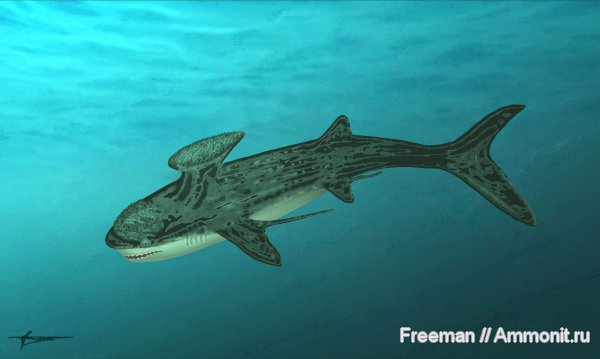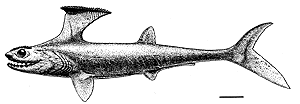
| Palaeos: |  |
Chondrichthyes |
| The Vertebrates | Symmoriida |
| Page Back | Unit Home | Unit Dendrogram | Unit References | Taxon Index | Page Next |
| Unit Back | Vertebrates Home | Vertebrate Dendrograms | Vertebrate References | Glossary | Unit Next |
|
Abbreviated Dendrogram
Thelodonti |--Placodermi | Eugnathostomata |--Chondrichthyes | |--+--Eugeneodontida || `--Chondrichthyes (Crown) | |--+--Cladoselachida | | `--Symmoriida | | |--Symmoriidae | | `--+--Stethacanthidae | | `--Falcatidae | | |--Damocles | | `--Holocephali | `--Elasmobranchii | |--Xenacanthida | `--Ctenacanthiformes | |--Ctenacanthidae | `--Euselachii | |--Hybodontiformes | `--+--Synechodontiformes | `--Neoselachii Teleostomi |
Contents
Overview |
 The Stethacanthid shark Akmonistion zangerli. Life reconstruction © Mikhail Tikhonov, original url |
Range: from the Late Devonian.
Phylogeny: ChondrichthyesCrown :: Cladoselachida + * : Symmoriidae + (Stethacanthidae + Falcatidae).
Characters: 0.1-1.5 m; body fusiform; mouth terminal or somewhat ventral; rostrum usually short; cladodont teeth with large median cusp; conspicuous, wide supraorbital roof; postorbital process of braincase (an extension of the "roof") then extends ventrally to support otic process of palatoquadrate laterally & anteriorly; shape and proportions of braincase elements highly variable; usual hatchet-shaped palatoquadrate; ventral calcified sheath over notochord in some forms; no calcified ribs; single dorsal fin; $ posterior dorsal fin with arrow-shaped or triangular plate posterior to fin [CS01*]; anal fin absent; tail fins often superficially symmetrical and deeply forked; very long, jointed metapterygium with free whip at end; $ proximal articular facet of metapterygium directed anteriorly [CS01*]; all fin radials clearly divided into proximal and distal sets (?); enlarged pelvic plate; $ myxopterygial claspers present (not homologous in detail with claspers of Recent sharks) [CS01*]; $ few scales except adjacent to lateral lines [CS01*].
Notes: "[CS01*]" indicates synapomorphies which were calculated from the data given in Coates & Sequeira (2001) using very different software (PHYLIP). Using the full Coates & Sequeira data set, this analysis yields a single most parsimonious tree identical to that found by the authors, but requires 3 more steps to reach it. The actual data used to generate these synapomorphies is slightly different and gives slightly different results.
Image: Cobelodus aculeatus, with several modifications, after Zangerl (1981), citing Zangerl, R & GR Case (1976), Cobelodus aculeatus (Cope), an anacanthous shark from Pennsylvanian black shales of North America. Paleontographica Abt. A 154: 107-157. Original length, about 1 m.
Links: Chondrichthyes; Untitled.
References: Carroll (1988); Coates & Sequeira (1998); Coates & Sequeira (2001) [CS01]; Janvier (1996); Zangerl (1981); Zangerl (1990). ATW021110.
Symmoriidae: Denaea, Cobelodus.
Phylogeny: Symmoriida : (Stethacanthidae + Falcatidae) + *.
Characters: $ glossopharyngeal (IX) nerve exits through metotic fissure [CS01*]; dorsal surface of head with large denticles; $ only one dorsal (reversal) [CS01*]; $ fin spine not composed of vascularised osteodentine (reversal) [CS01*]; $ fin spine does not precede dorsals (reversal) [CS01*]; $ caudal neural and supraneural spines not extended (reversal) [CS01*]; caudal fin usually symmetrical; $ procoracoid directed posteriorly [CS01*]; pectoral fins long; $ pelvic plate semicircular with anterolateral concavity [CS01*]; $ claspers with clawed terminus [CS01*].
Notes: "[CS01*]" indicates synapomorphies which were calculated from the data given in Coates & Sequeira (2001) using very different software (PHYLIP). Using the full Coates & Sequeira data set, this analysis yields a single most parsimonious tree identical to that found by the authors, but requires 3 more steps to reach it. The actual data used to generate these synapomorphies is slightly different and gives slightly different results.
Links: Untitled (Japanese: teeth and some general anatomy).
References: Coates & Sequeira (2001) [CS01]. ATW030702
 Stethacanthidae:
Akmonistion, Stethacanthus.
Stethacanthidae:
Akmonistion, Stethacanthus.
Range: Carboniferous?
Phylogeny: Symmoriida :: Falcatidae + *.
Characters: narrow suborbital shelf [CS01]; amphistylic jaw
suspension; $ "basicranium encloses Y-shaped canal
enclosing division of dorsal into lateral aortae" [CS01]; hyomandibula
short and crescent-shaped; $ whorls of fused, 3-cusped tooth
families occur close to the level of the jaw articulation [CS01]; oropharynx
lined with denticles; prominent caudal neural arches [CS01]; elaborate spine
& brush structure on first dorsal [CS01];  $
anterior dorsal fin with triangular osteodentine spine, having distinct
anterior shoulder and seated on baseplate containing globular calcified
cartilage (see image at left) [CS01]; $ baseplate continuous
with spine-brush complex [CS01]; posterior dorsal supported with radials and
triangular cartilage [CS01]; caudal axis strongly upturned [CS01]; hypochordal
lobe supported by long, distally splayed radials [CS01]; pectoral fins with long
metapterygial whip [CS01]; scales with single crowns [CS01]; scales non-growing
and restricted to discrete areas [CS01]; lateral line scales C-shaped [CS01];
strong sexual dimorphism, with highly modified anterior dorsal fin.
$
anterior dorsal fin with triangular osteodentine spine, having distinct
anterior shoulder and seated on baseplate containing globular calcified
cartilage (see image at left) [CS01]; $ baseplate continuous
with spine-brush complex [CS01]; posterior dorsal supported with radials and
triangular cartilage [CS01]; caudal axis strongly upturned [CS01]; hypochordal
lobe supported by long, distally splayed radials [CS01]; pectoral fins with long
metapterygial whip [CS01]; scales with single crowns [CS01]; scales non-growing
and restricted to discrete areas [CS01]; lateral line scales C-shaped [CS01];
strong sexual dimorphism, with highly modified anterior dorsal fin.
Note: Coates & Sequeira (2001) sometimes avoid calling the spine-brush complex a "dorsal fin." It is certainly unclear whether it is homologous to the dorsals of more conventional sharks. These authors are also rather unhappy with the odd results of their parsimony analysis and offer an alternative cladogram (the details of which are to be published), with "arguably more conventional" results. However, lacking the details of the alternative analysis, the pure parsimony results have been adopted here.
Image: (right) Akmonistion life reconstruction from [CS01]. Scale bar is 5 cm.
Links: Fish of the Bear Gulch; Stethacanthidae (notes on sexual dimorphism by Prof. Lund); Poecilodus jonesii - (teeth).
References: Coates & Sequeira (2001) [CS01]. ATW031211.
Range: fr D.
Phylogeny: Symmoriida :: Stethacanthidae + *: Damocles + Holocephali.
Characters: $ loss of persistent metotic-occipital fissure (reversal) [CS01*]; $ glossopharyngeal (IXth) nerve does not exit through metotic fissure (reversal) [CS01*]; $ loss of hyoid articular area on posterolateral angle of otic capsule (reversal) [CS01*]; $ loss (reversal) of high aspect-ratio lunate heterocercal caudal fin (hypochordal radials short and/or segmented) [CS01*]; $ notochord terminates almost horizontally [CS01*]; $ pectoral articular surface stenobasal (reversal) [CS01*].
Links: elasmo.com, Wikipedia.
References: Coates & Sequeira (2001) [CS01].
Notes: [1] "[CS01*]" indicates synapomorphies which were calculated from the data given in Coates & Sequeira (2001) using very different software (PHYLIP). Using the full Coates & Sequeira data set, this analysis yields a single most parsimonious tree identical to that found by the authors, but requires 3 more steps to reach it. The actual data used to generate these synapomorphies is slightly different and gives slightly different results. [2] All these reversals are not as unlikely as it may appear. They merely reflect the increasing consolidation of the palatoquadrate with the braincase and concommitant adaptation to a duraphagous, slow-moving, benthic habit -- a tendency finding its logical endpoint in the holocephalians. 011209.
Damocles: another stethacanthid-type shark with a particularly elaborate head-dress.
Phylogeny: Falcatidae : Holocephali + *.
Characters: pointed snout and crown of head and neck denticles, females naked and with shorter snout; orbits large; males with a large forwardly pointed dorsal spine; $ Loss of second dorsal fin (reversal) [CS01*]; nearly symmetrical high aspect ratio tail, denoting some cruising ability; $ pectoral fins elevated [CS01*]; pectoral fin with trailing metapterygial whip, otherwise thick and relatively stiff.
Links: Megaladon.html.
References: Coates & Sequeira (2001) [CS01].
Notes: "[CS01*]" indicates apomorphies which were calculated from the data given in Coates & Sequeira (2001) using very different software (PHYLIP). Using the full Coates & Sequeira data set, this analysis yields a single most parsimonious tree identical to that found by the authors, but requires 3 more steps to reach it. The actual data used to generate these synapomorphies is slightly different and gives slightly different results. 020223.
| Page Back | Unit Home | Glossary | Page Top | Page Next |
checked ATW060126